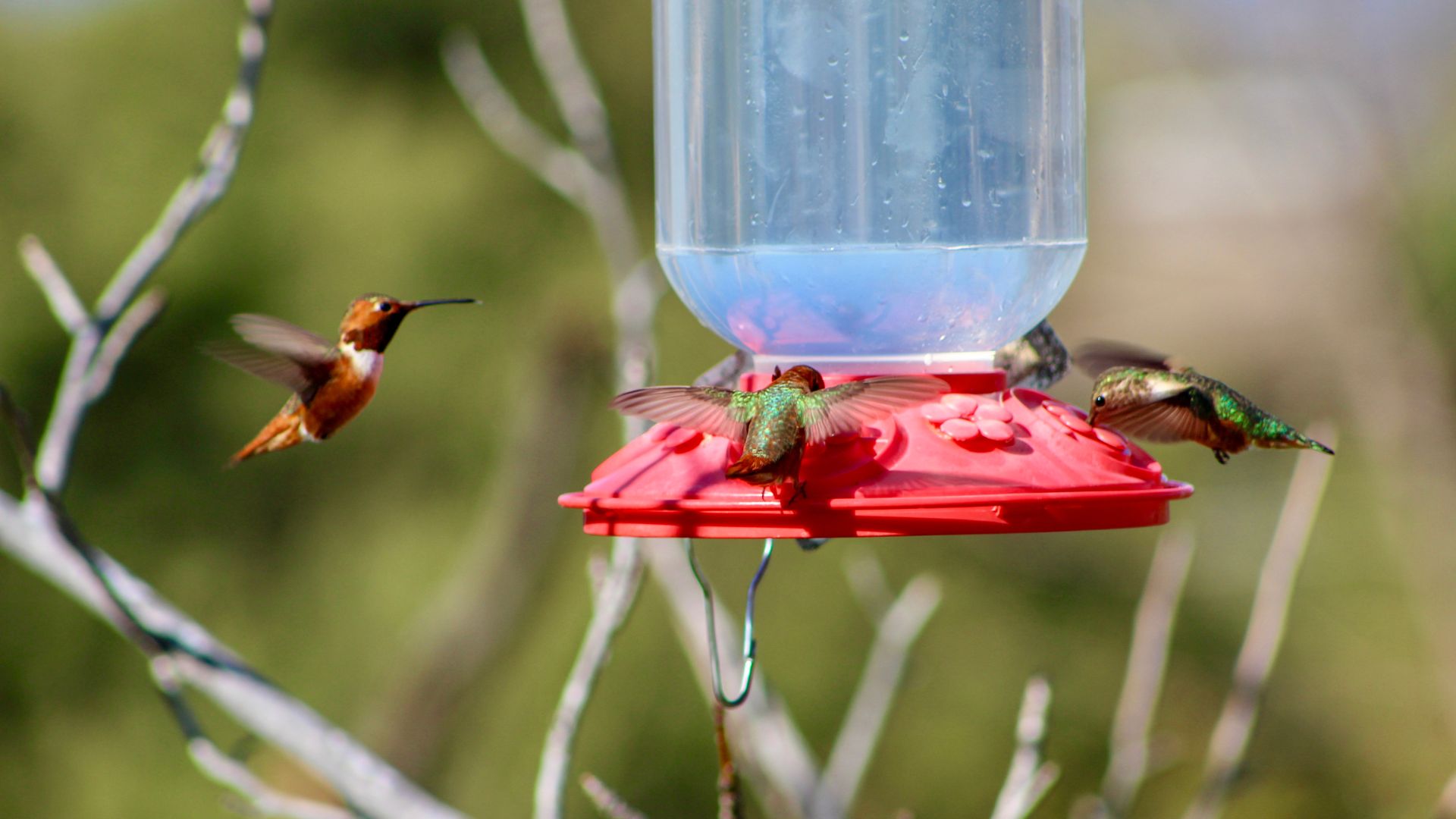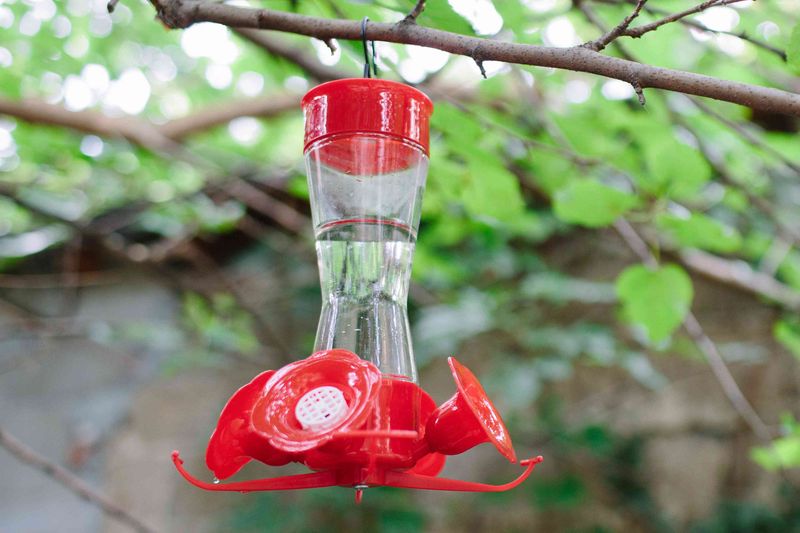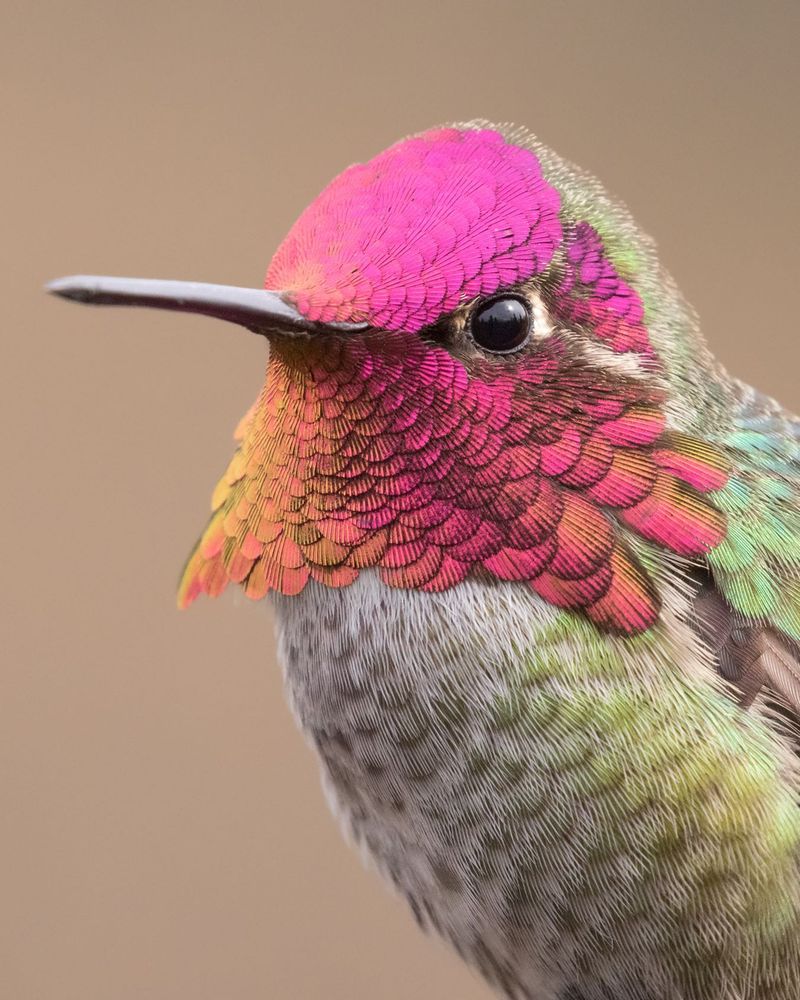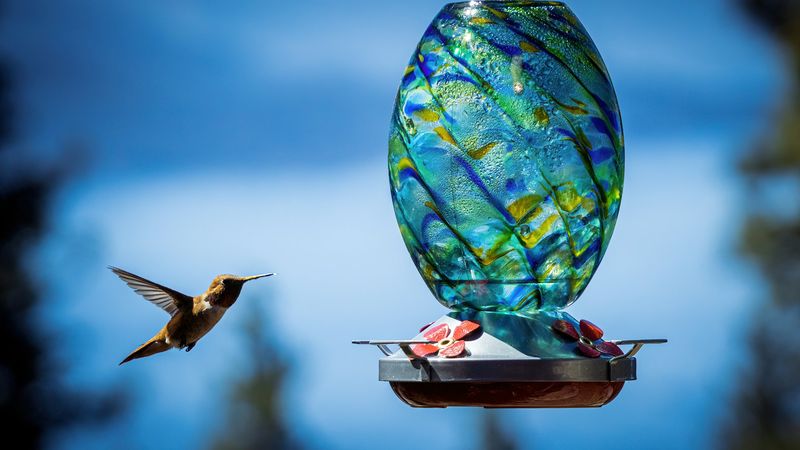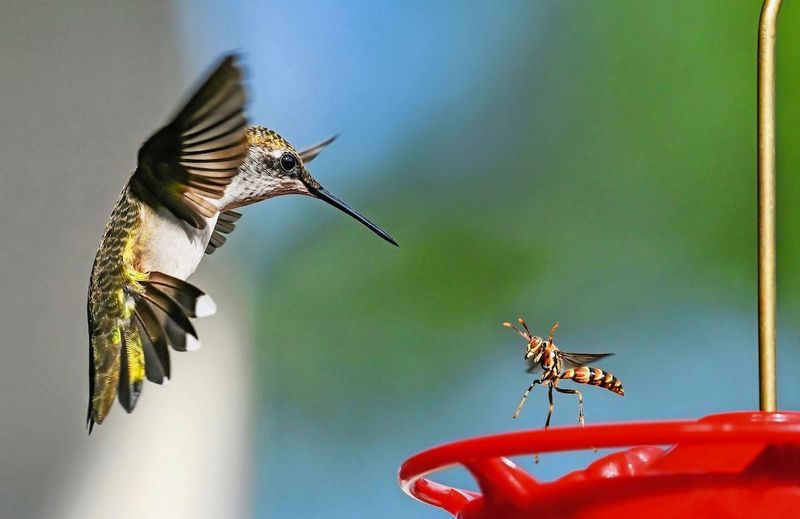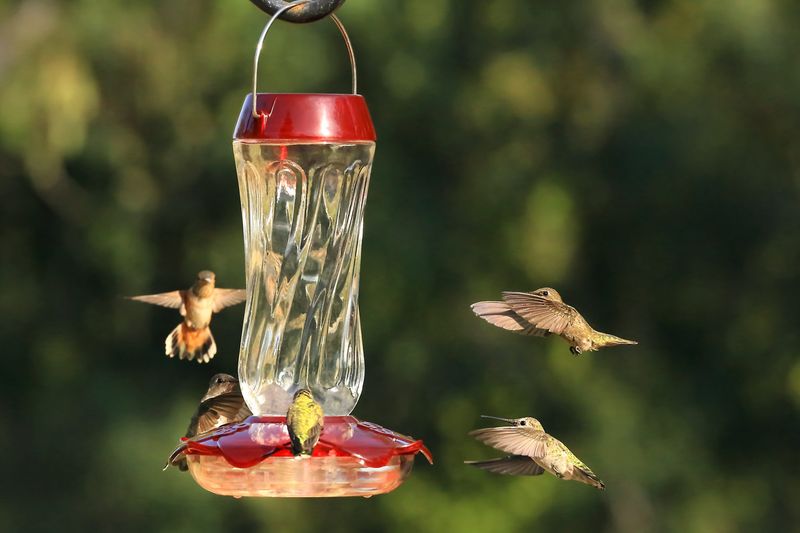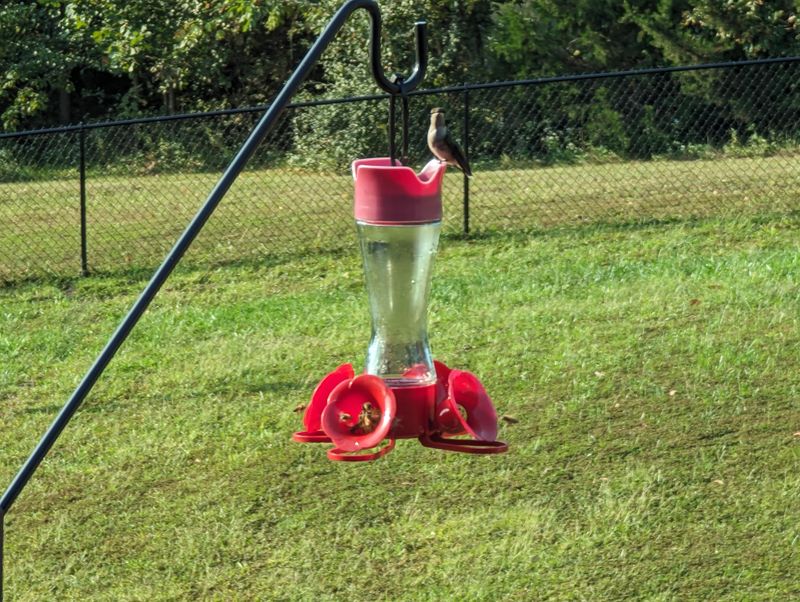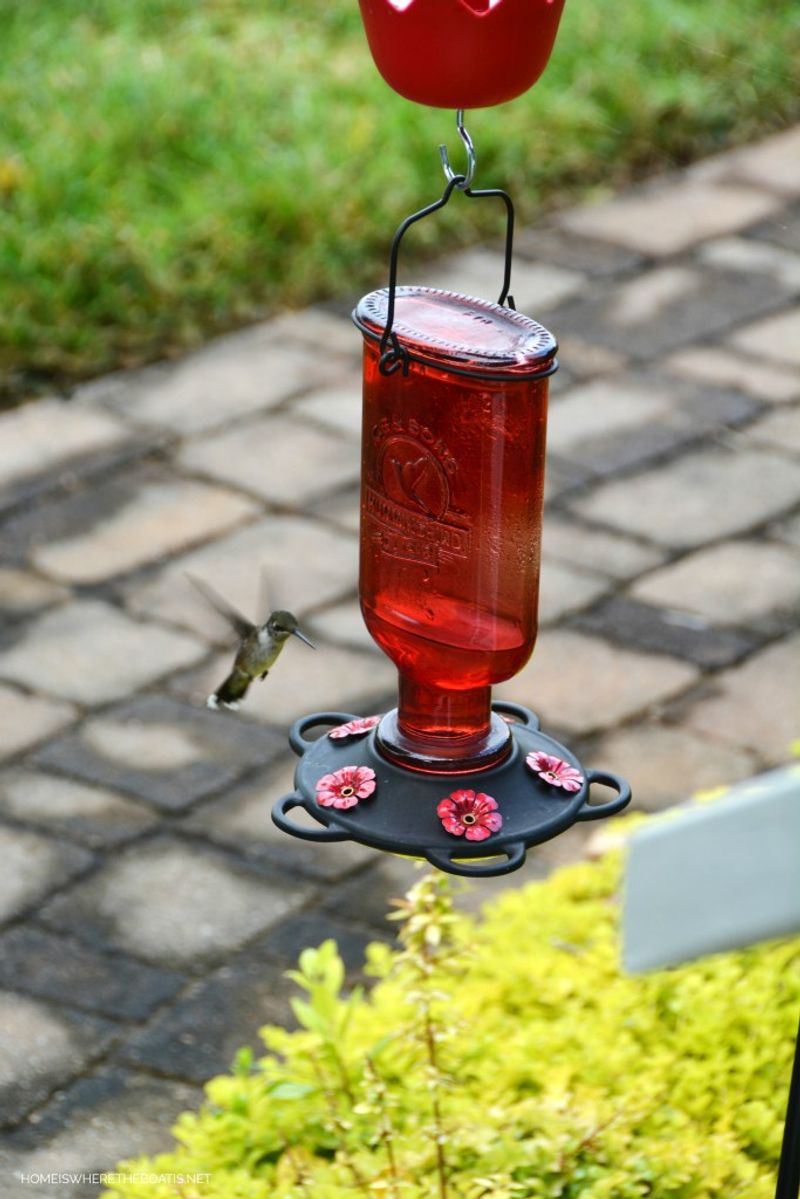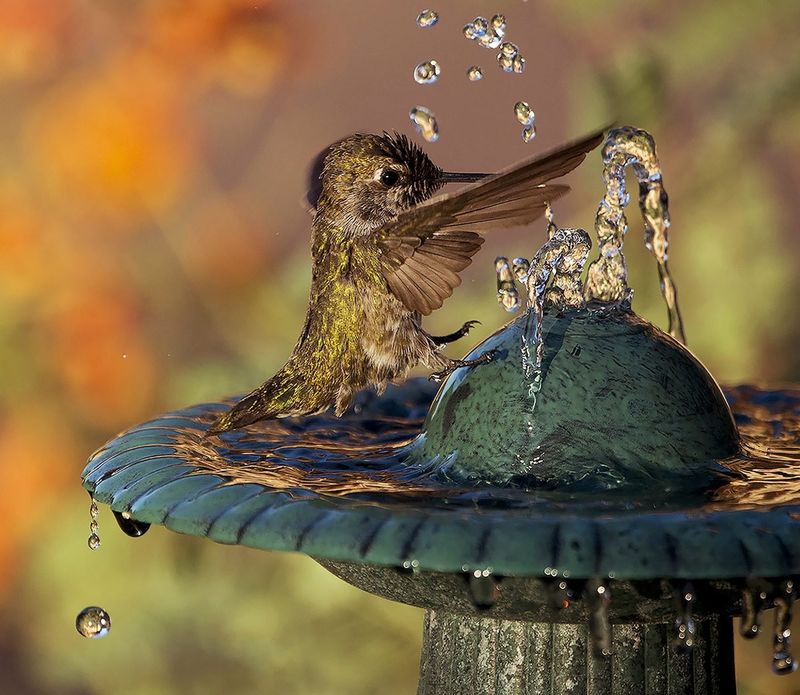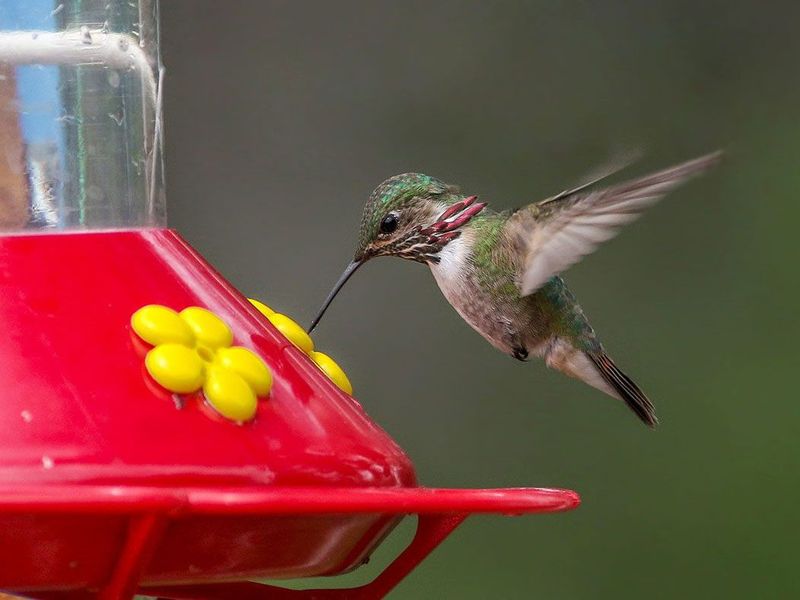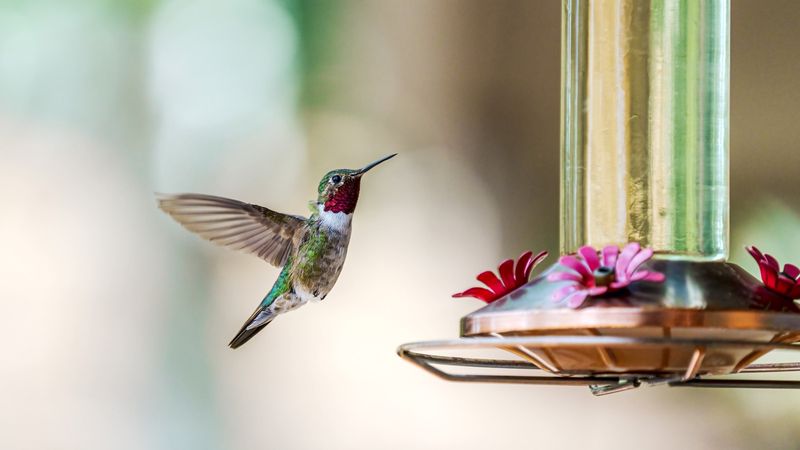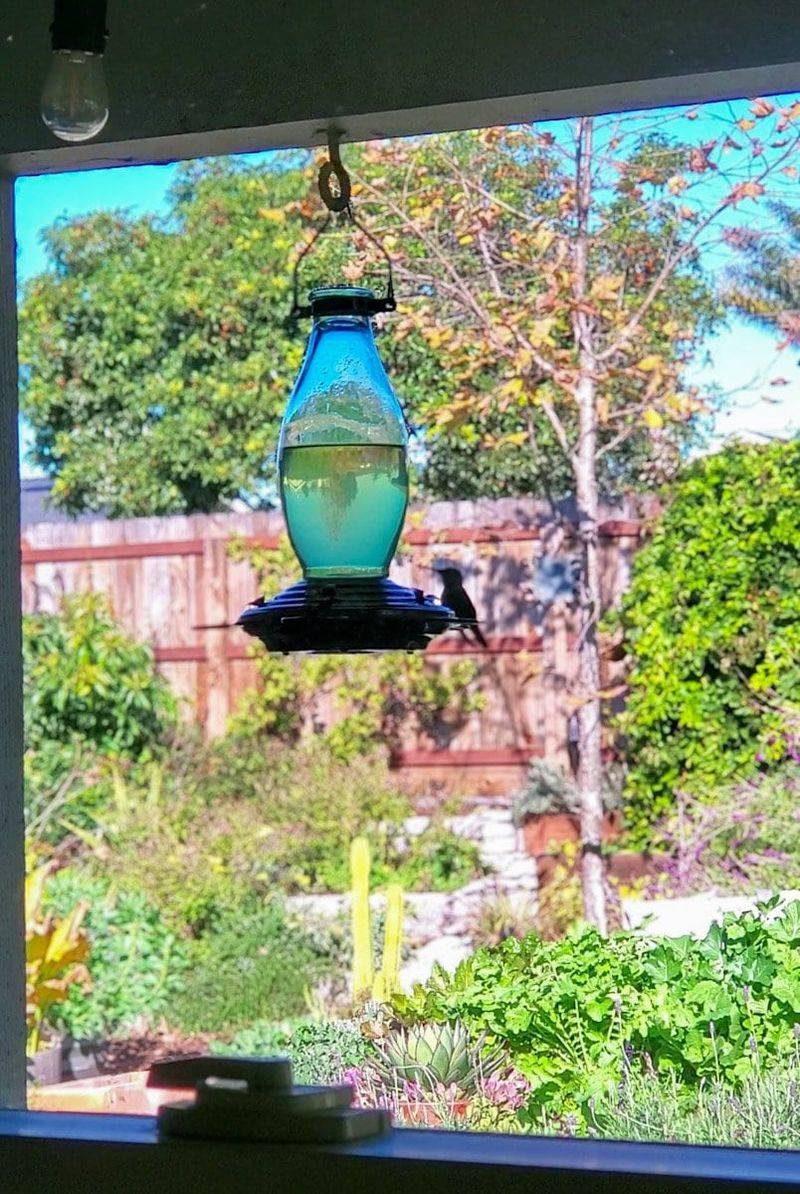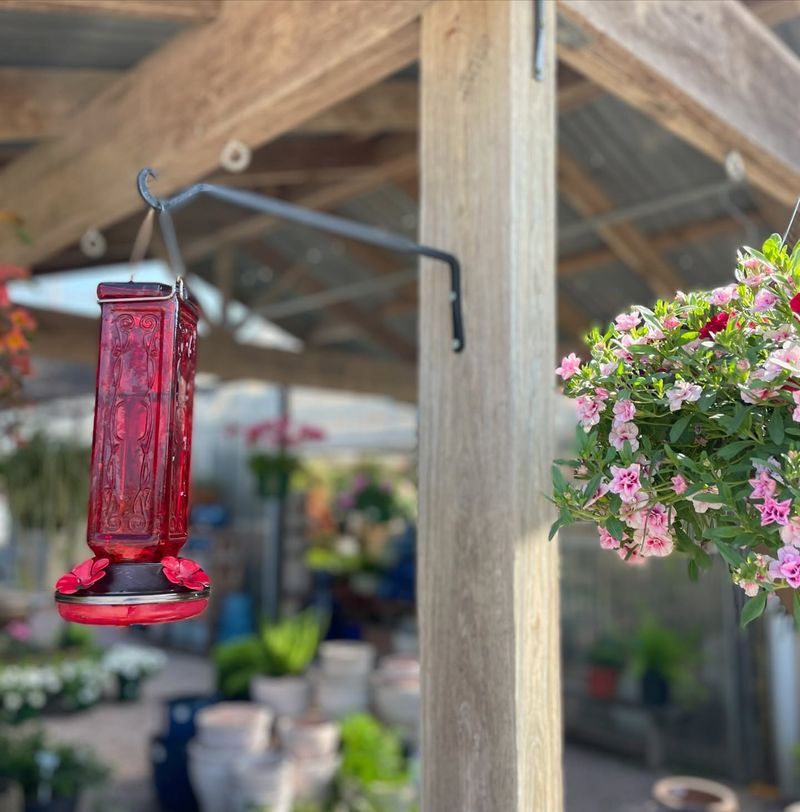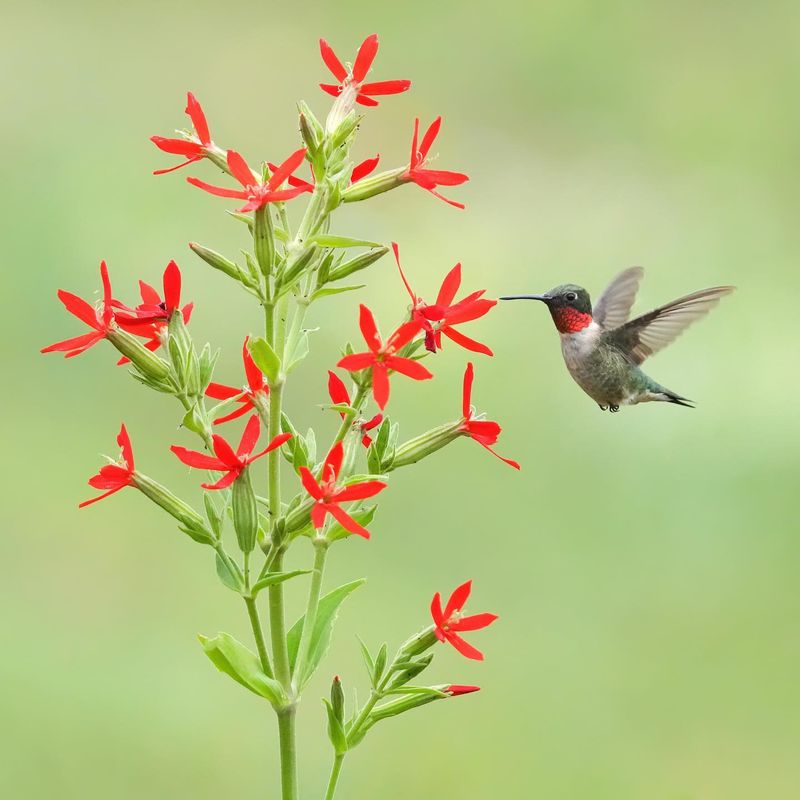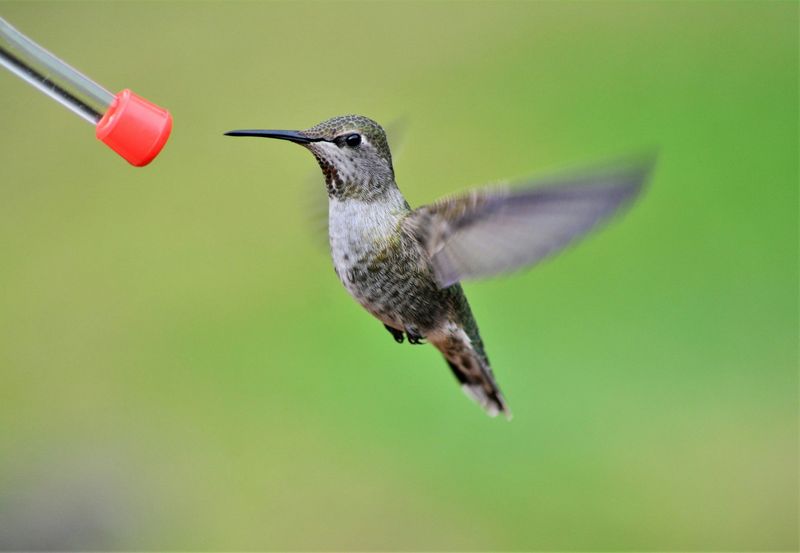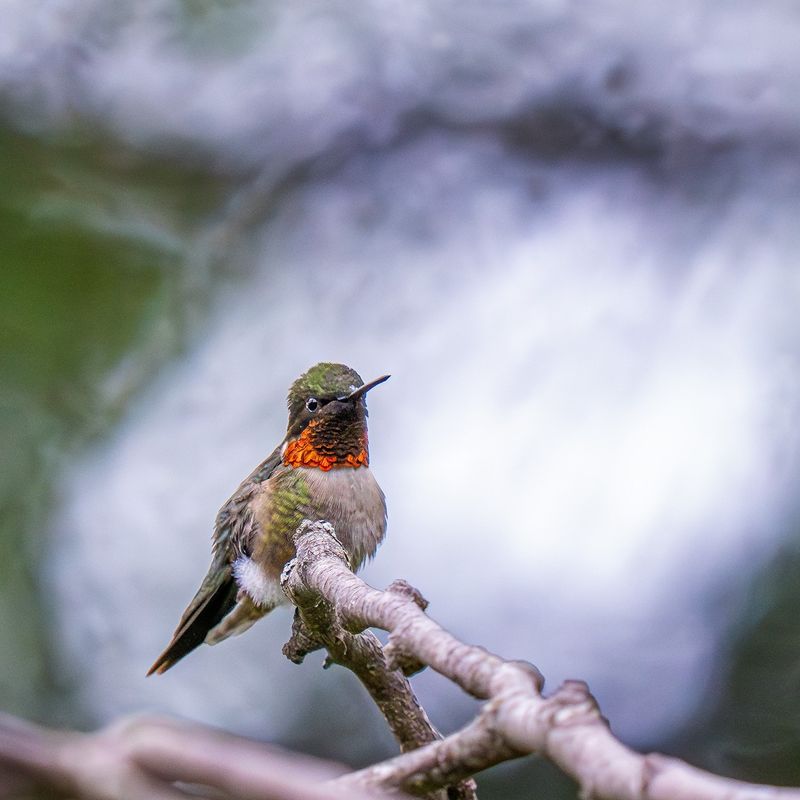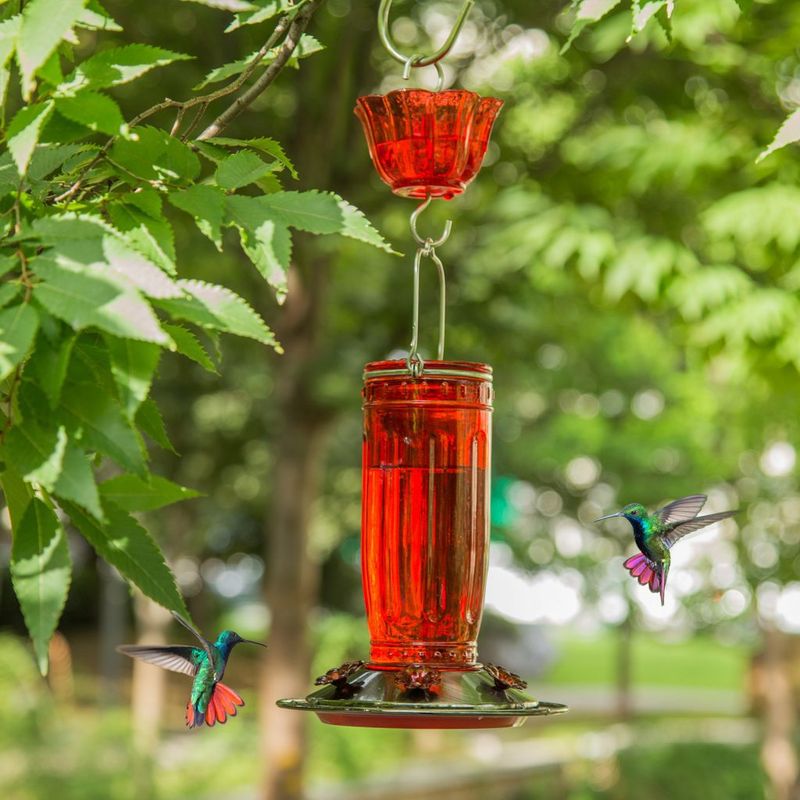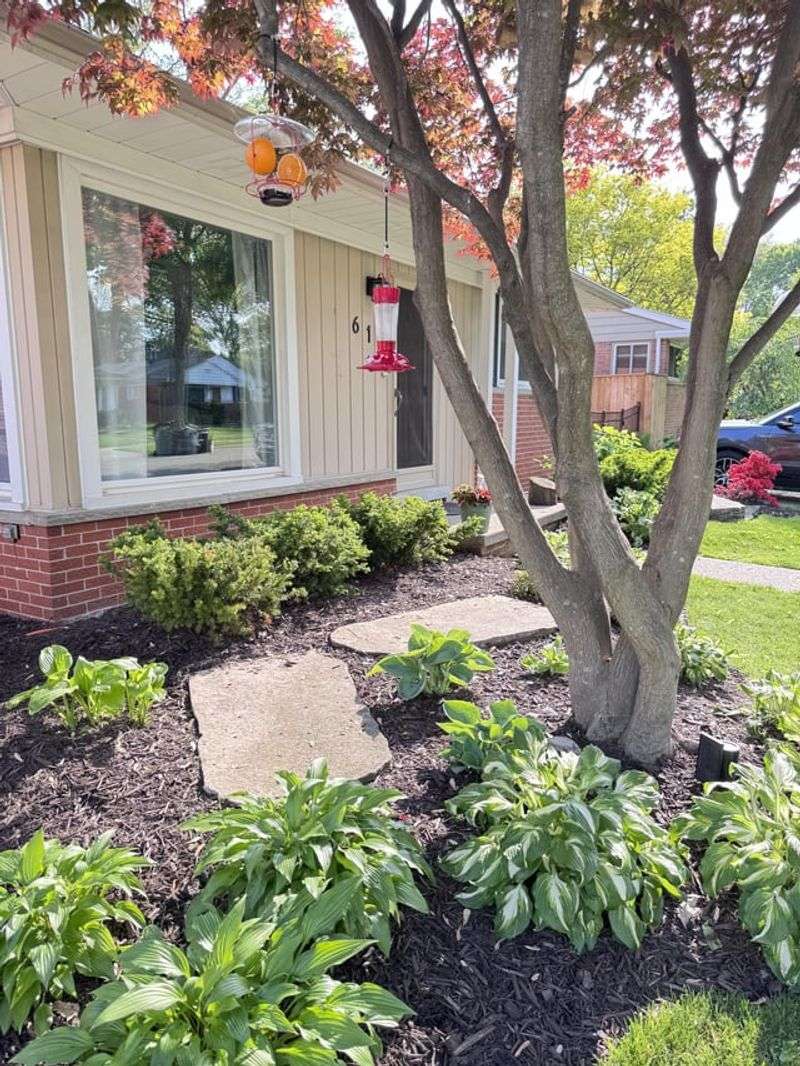Hanging a hummingbird feeder in your yard feels like an easy way to invite these tiny wonders, but where you put it really matters.
The wrong spot can scare them off, put them in harm’s way, or even attract unwanted pests. Finding the right place to hang your feeder can turn your yard into a buzzing hummingbird hangout that keeps them coming back again and again.
With a little know-how, you’ll create a safe, welcoming space that lets you enjoy these fascinating little birds up close—day after day.
1. Near Outdoor Cats
Cats are natural hunters that can’t resist the movement of hummingbirds. Even well-fed pets maintain their hunting instincts, making them a serious threat to these tiny birds that hover in place while feeding.
Hanging feeders where cats lounge or patrol regularly creates a dangerous situation. The birds become easy targets when they’re focused on drinking, completely unaware of the predator waiting to pounce.
Keep feeders at least 15 feet from areas where cats frequent, and ideally hang them high enough that cats can’t reach them by jumping. The safety of your hummingbird visitors should always come before convenience of feeder placement.
2. Right Next To Windows
Window collisions kill millions of birds annually, and hummingbirds aren’t exempt from this danger. When feeders hang directly against windows, these speedy fliers can’t distinguish between reflections and real space, often crashing at full speed.
The impact can be fatal even for larger birds, but hummingbirds’ delicate frames make them especially vulnerable. Their incredible speed—up to 30 mph in flight—turns windows into deadly obstacles when they’re startled or trying to escape.
Either place feeders more than 30 feet from windows so birds can clearly see the house as a structure, or within 3 feet so they can’t build up dangerous speed before any potential collision.
3. In Direct, All-Day Sunlight
Full sun locations might seem ideal for flower-loving hummingbirds, but they’re actually problematic for feeders. Sugar water ferments quickly in heat, sometimes spoiling within just a day in hot weather, potentially making birds sick.
The sun’s intensity also encourages rapid growth of harmful bacteria and mold in the nectar. What started as a healthy meal can quickly become dangerous to the very birds you’re trying to help.
Hot feeders can actually burn tiny hummingbird tongues when the metal parts heat up. Look for spots that get morning sun but afternoon shade to keep your nectar fresh longer while still being visible to passing birds.
4. Near Wasp Or Hornet Nests
Wasps and hornets love sugar water just as much as hummingbirds do. Hanging feeders near their nests creates competition that the birds usually lose. These aggressive insects will dominate a feeder, keeping the timid birds away.
Worst of all, the insects can actually harm the tiny birds. Wasps sometimes sting hummingbirds around the eyes and mouth when competing for the same food source, causing injuries or even death to these delicate creatures.
Check your hanging spots carefully for any paper wasp nests or hornet activity before setting up feeders. If insects become a problem, try feeders with bee guards or ones specifically designed to discourage wasps while still allowing hummingbird access.
5. Where You Can’t Reach Easily
Hanging feeders in hard-to-reach spots might seem clever at first – perhaps high in a tree or on a second-story overhang. The problem comes when you need to clean and refill them, which happens more often than you might expect.
Sugar water needs changing every 2-3 days in warm weather to prevent fermentation and harmful mold growth. Skipping regular cleaning because the feeder is inconvenient to reach puts birds at risk of disease.
Forgotten feeders become breeding grounds for bacteria and fungi. Choose locations you can access without ladders or special equipment, ensuring you’ll keep up with the frequent maintenance these feeders require for the health of your hummingbird visitors.
6. Above Decks Or Patios
Sticky drips are inevitable with hummingbird feeders, regardless of how careful you are. The sugar water leaks from feeding ports, overflows during filling, or spills when birds jostle the feeder, creating a messy situation on the surfaces below.
Beyond the annoyance of sticky furniture, these sugary drips attract ants, wasps, and other unwanted insects to your outdoor living spaces. What started as bird-watching enjoyment becomes a pest problem directly overhead.
The constant cleaning required for decks and patio furniture beneath feeders quickly becomes tiresome. Position feeders away from seating areas and outdoor dining spaces, preferably over natural ground where occasional drips simply water your plants rather than creating cleaning chores.
7. Near Air Conditioners Or Fans
The powerful airflow from outdoor AC units and fans creates invisible turbulence that’s challenging for tiny hummingbirds. These birds weigh less than a penny, making them vulnerable to even slight air currents when trying to hover and feed.
Constant buffeting from artificial air currents makes precision feeding difficult and stressful. Hummingbirds need stability to insert their long bills into feeding ports, and fighting against air currents wastes precious energy they need for survival.
The mechanical noise from these devices can also deter visits from these naturally cautious birds. Place feeders at least 15 feet away from any outdoor mechanical equipment, giving birds a calm, quiet spot to feed without fighting against disruptive air currents.
8. Near Bird Baths Or Pools
Water features seem like natural companions for feeders, but they attract larger birds that can intimidate hummingbirds. Jays, mockingbirds, and other territorial species congregating at bird baths often chase away the much smaller hummers.
Splashing water can dilute the nectar in nearby feeders if they’re positioned too close. Even small amounts of water contamination can cause the sugar solution to ferment faster, creating potential health hazards.
Predators like outdoor cats often stake out water features, making nearby feeders dangerous zones for vulnerable hummingbirds. Keep feeders and water features separated by at least 15-20 feet to create distinct zones that allow all birds to use your yard safely without unnecessary competition.
9. In Areas With Pesticide Use
Gardens treated with chemicals pose serious dangers to hummingbirds. These tiny birds have extremely fast metabolisms, making them particularly vulnerable to even small amounts of toxins that might not immediately affect larger animals.
Pesticides don’t just contaminate plants but also the insects hummingbirds eat. Many people don’t realize that hummingbirds need protein from small insects along with nectar, and contaminated bugs can poison them.
Even residue that drifts onto feeders can be ingested during feeding. Hang feeders well away from any areas where you use garden chemicals, and consider creating a pesticide-free zone for your hummingbird habitat to protect these sensitive visitors from harmful exposure.
10. Too Close To Other Feeders
Male hummingbirds are fiercely territorial around food sources, often spending more energy chasing away rivals than actually feeding. Placing multiple feeders too close together creates constant battles that stress the birds and reduces feeding opportunities for all visitors.
Dominant birds will try to guard all nearby feeders if they can see them from one position. This territorial behavior means only one bird gets to feed despite your efforts to provide for many.
The constant aerial dogfights and chittering arguments deplete the birds’ energy reserves unnecessarily. Space feeders at least 15-20 feet apart, preferably with visual barriers between them, to prevent one aggressive bird from monopolizing all your feeding stations.
11. In Completely Enclosed Areas
Fully enclosed spaces like screened porches might seem perfect for close-up viewing, but they create dangerous traps for hummingbirds. These birds often can’t find their way out once they’ve entered through small openings, leading to stress and exhaustion.
The confined space prevents their natural escape routes when they feel threatened. Hummingbirds rely on quick vertical escapes when startled, which enclosed ceilings block, causing panic and potentially harmful collisions.
Trapped birds may eventually die from exhaustion or starvation if unable to exit. Always place feeders in open areas where birds have clear flight paths in multiple directions, allowing them to approach and leave freely without navigating confusing barriers that could turn your feeding station into an accidental trap.
12. Under A Covered Porch
Porches with roofs provide perfect protection from the elements while keeping feeders accessible. The overhead covering shields sugar water from direct sun and rain, helping nectar stay fresh longer without fermenting quickly in summer heat.
I’ve found that feeders under my porch eaves rarely need cleaning due to fallen leaves or tree debris. This cleaner environment reduces contamination risks while making maintenance significantly easier throughout the season.
The shade also keeps the feeding ports cooler on hot days, preventing the metal parts from heating up and potentially burning tiny hummingbird tongues. Just make sure to hang the feeder near the outer edge of the roof where birds can spot it easily during their regular patrols.
13. Near Flowering Plants
Hanging feeders near natural nectar sources creates a complete feeding station that attracts more birds. Hummingbirds naturally search for flowers, so they’re more likely to discover your feeder when it’s positioned near plants they already visit.
Flowering plants like salvias, bee balm, or trumpet vine act as natural billboards advertising your feeding station. When birds come for the flowers, they notice your feeder as a bonus food source, especially helpful during times when blooms are scarce.
The combination of natural nectar and sugar water provides better nutrition than feeders alone. My most successful feeding spot has always been near my butterfly bush, where hummingbirds alternate between the flowers and the feeder throughout their visits, creating more viewing opportunities than isolated feeders ever did.
14. From Shepherd’s Hooks
Shepherd’s hooks offer ideal placement flexibility that lets you position feeders exactly where they need to be. Unlike fixed locations on buildings, these movable stands can be relocated seasonally or whenever feeding patterns change.
Their height puts feeders at perfect eye level for humans while keeping them safely above most ground predators. This middle-height zone creates comfortable feeding stations that birds seem to prefer over extremely high or low positions.
The open area around standalone hooks gives hummingbirds clear flight paths from all directions. I’ve noticed birds approach more confidently when they can see potential threats from any angle, rather than having a structure blocking one side of their view. This visibility creates a sense of security that encourages more frequent visits.
15. At Forest Edge Locations
The transition zone between open areas and trees creates a natural hummingbird highway. These birds instinctively travel along habitat edges rather than through wide open spaces, making forest margins prime real estate for feeder placement.
Edge locations provide nearby perching spots on branches where birds can rest between feedings. Hummingbirds actually spend most of their time perching, not flying, so having these rest stops within 10-15 feet of feeders encourages longer, more frequent visits.
The partial tree cover offers quick escape routes from predators while still providing enough openness for easy approaches. My edge-placed feeders consistently attract more visitors than those in either fully open areas or deep within tree cover, confirming what researchers have observed about hummingbird travel preferences.
16. At Varied Heights
Hanging multiple feeders at different levels creates a more natural feeding environment that reduces competition. In nature, flowers grow at various heights, and this diversity helps prevent dominant birds from controlling all food sources.
Different species actually prefer different feeding heights. Rufous hummingbirds often feed higher than ruby-throats, for example. By varying your feeder heights from 5 to 8 feet, you accommodate these natural preferences and attract more species.
The height variation also creates distinct territories that allow multiple birds to feed simultaneously without conflict. Last summer, I hung three feeders at different heights around my yard and finally achieved peaceful coexistence between the resident male and several females that previously couldn’t approach without being chased away.
17. Within View Of Your Window
Positioning feeders where you can easily watch them transforms bird feeding from a chore into daily entertainment. The ideal distance is about 10-12 feet from windows—close enough for detailed viewing but far enough to prevent collisions.
Regular observation helps you monitor feeder conditions without having to physically check them constantly. You’ll notice when nectar levels drop, when ports get clogged, or if wasps start to become a problem, allowing for timely maintenance.
The window view creates opportunities to identify individual birds by their unique behaviors and markings. After watching my window feeder for just a week, I could distinguish between the territorial male and the female who always approached from the left—turning simple bird feeding into a fascinating ongoing nature study.

